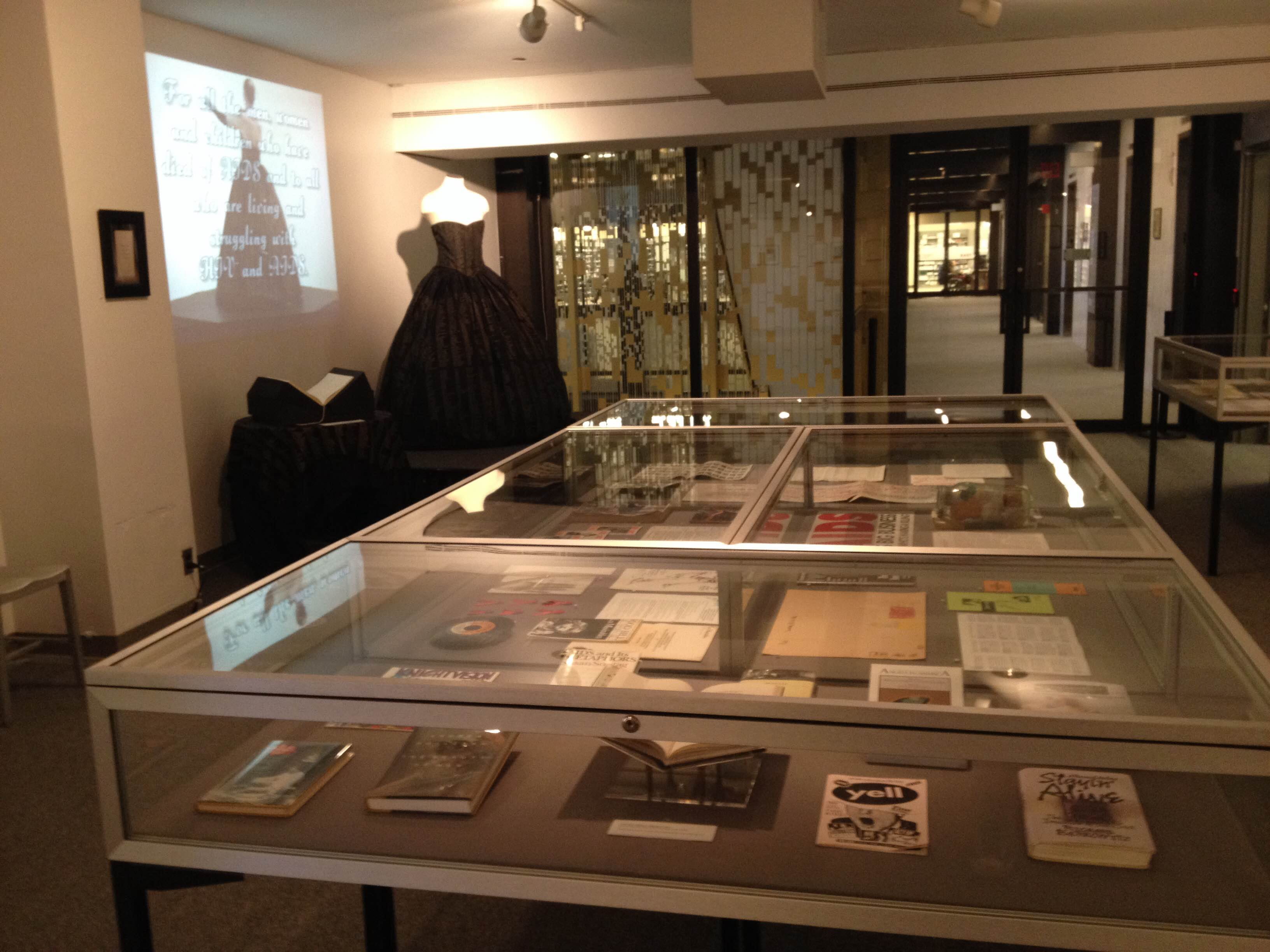By guest contributor Mia D’Avanza
A screen-printed poster with the familiar Coca-Cola logo, reading “Enjoy AZT”, greeted visitors to the recent show positive/negative: HIV/AIDS at NYU’s Tracey/Barry Gallery. The poster, produced for AIDS activist group ACT UP, alters the Coke logo to criticize the high cost and low efficacy of AIDS drug AZT. Suggesting that the pharmaceutical company producing AZT is profiting from the epidemic, the poster asks, “Is this Health Care or Wealth Care?” It is a fine example of the dissenting voices to be found in this exhibition, and the urgency with which individuals and groups challenged the status quo during the AIDS epidemic.

(Photo courtesy of the author.)
Curated by archivist Brent Phillips, positive/negative presented selected archival material from the Fales Library that documents “the positive and negative reactions to AIDS in the U.S.”, including public health brochures, magazines, posters, zines, art films, photographs, documented performance pieces, and news clips. The documentary collections strategy of the Downtown Collection, from which these materials are culled, was reflected in the spare design of the show. The materials are loosely arranged, reflecting a spectrum of reactions to the biggest public health crisis of the 1980s and 1990s in the U.S. The brochure that accompanies the exhibition includes a checklist of materials and an introduction from the curator. This introduction serves as a timeline and certainly helps provide context for these materials, as there is very little interpretive text within the show.
The scope begins with Reagan Era, when HIV and then the AIDS epidemic were first detected and identified (1981-83). Conservative politicians, including President Reagan, approached the epidemic as unworthy of real attention beyond ridicule and moral judgment. Until 1986, his administration advised the media that “the Surgeon General would not answer questions about AIDS, and that he was not to be asked about it.”
Finally in 1986 Surgeon General C. Everett Koop released his report on the epidemic, which was progressive in its urging for early AIDS education in schools and frank descriptions of preventative options, including condom use. Koop’s viewpoint is represented in the exhibition by his article for the journal AIDS Patient Care titled “An AIDS Health Care Network—The Time is Now!”
In 1987 President Ronald Reagan mentioned AIDS publicly for the first time. As deaths increased over the next ten years, it could no longer be denied that there was a massive health crisis, and gay men were not the only ones at risk. However, those who contracted the disease through blood transfusion or in utero (usually children and heterosexual men and women) were often portrayed as “innocent victims”. This dynamic of victims versus deviants would color the discussion of AIDS in the years to come.
Much of the positive response here reflects the “Silence=Death” ethos of ACT UP, which tellingly stands for AIDS Coalition to Unleash Power. Their message of the power of each person to enact change, and exerting influence through group advocacy, resonates throughout the exhibition. Artifacts of non-violent mass action are seen in film clips from the Gay Cable Network’s 1990-91 coverage of ACT UP demonstrations at the National Institute of Health and Grand Central Terminal to protest high drug prices and government inaction despite escalating AIDS deaths. Powerful personal narratives of loss and living with HIV/AIDS are also presented, in the form of drawings, open letters, and memorials to loved ones by artists Chloe Faith Dzubilo, Keith Haring, and David Wojnarowicz. In a 1989 ACT UP support letter written by Haring, he tells his own story of being diagnosed with HIV and emphasizes the affirmative meaning of the word “positive”, which had become associated with test results, fear, and the stigma of an incurable disease.
Photographer Bill Bytsura’s portraits of AIDS activists from 1989–1998 allow his subjects to speak for themselves in the accompanying subject statements. Next to his portrait of Mona Bennett of Atlanta, her typed words echo Haring’s message that even seemingly banal tasks can help the fight against AIDS.
One of the last pieces in the show is also the most spectacular. Hunter Reynolds’ “Patina du Prey’s Memorial Dress”, 1994, is a black ballgown printed in gold with the names of those who have died from AIDS. The gown is presented on a platform in front of a video that documents the artist in the process of applying makeup and becoming his alter ego du Prey, getting ready at a vanity and wearing the dress, then standing on a slowly rotating dias, gloved arms outstretched. The screen tells us, “For us, it is hope upon which I am turning.”

Patina du Prey’s Memorial Dress. (Photo courtesy of the author.)
These testaments to the human face of an epidemic sit side-by-side with U.S. Government documents invoking biblical scripture in relation to AIDS and photographs of conservative religious groups declaring “God Damns Sodomy.” In this way the exhibition manages to present both the macro view of the Reagan administration’s inaction and tone of moral judgment in the face of HIV/AIDS, and the humanizing stories of individuals who called out employment, school, and housing discrimination, decried mass testing and quarantine suggestions, and demanded better treatment options.
positive/negative: HIV/AIDS was on view October 12, 2015—January 15, 2016 in the Tracey/Barry Gallery, Bobst Library at NYU.
Mia D’Avanza is the Head of Circulation at the New York Society Library. She is co-editor of Frida Kahlo’s Garden, the catalog accompanying the exhibition at the New York Botanical Garden.



9 Pingbacks